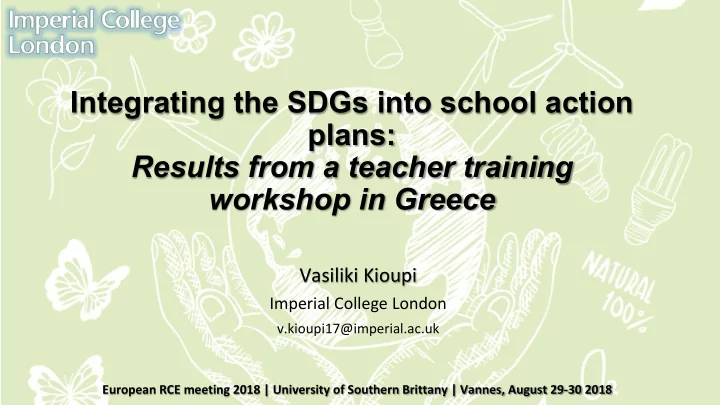

Integrating the SDGs into school action plans: Results from a teacher training workshop in Greece Vasiliki Kioupi Imperial College London v.kioupi17@imperial.ac.uk European RCE meeting 2018 | University of Southern Brittany | Vannes, August 29-30 2018
The workshop • Entitled: ‘Developing a school action plan inspired by the 17 SDGs’ • In collaboration with the Centre for ESD (EE Centre) in Drapetsona • 18 primary schools of the school district of Piraeus participated • Groups of 4 to 5 teachers including head teachers • 18 June 2018
Educational Objectives • Reforms in the education system structure • Schools to submit action plans for Sustainability • Train school groups in the development of action plans • Whole school approach • Introduce teachers to the SDGs • Assess knowledge of global affairs • Assess values regarding sustainability
Brainstorming session • Sustainability is complex • What do primary school teachers think about it?
Assessing prior ‘global knowledge’ Questions (Test developed by Hans Rosling, 2013): 1) In 1950 there were fewer than one billion children (aged 0-14) in the world. By 2000 there were almost two billion. How many do UN experts think there will be in 2100? 2) Which map best shows how the world's seven billion people are spread between the Americas, Europe, Africa and Asia? Each figure represents one billion. 3) What is the average life expectancy at birth in the world today? 4) What is the literacy rate for adults in the world as a whole today? 5) Which curve shows the present income distribution of the world as a whole, measured in dollars earned per day? 6) In the world as a whole, men now aged 25-34 years spent a total of eight years at school. How long did women in the same age group spend at school? 7) In the last 20 years, how did the proportion of the world population living in extreme poverty change? 8) About * of world energy comes from solar and wind power? 9) In 1965 women had five babies, on average worldwide. How many do they have on average today?
Knowledge test results Primary school teacher responses by question 90 80 36% 70 27% 60 15% 10% 50 40 30 20 10 0 1 2 3 4 5 6 7 8 9 1 2 3
The SDGs question game • Interactive PowerPoint based game with questions based on data for the SDGs • Participants need to identify the right answer and connect to one of the SDGs
Development of action plans • School groups from neighbouring schools worked together • Brainstormed on improvement points in their schools • Two major issues where identified: • School infrastructure (green space, shaded areas, energy efficiency) • School relationships- conflict management
Connection of issues to the SDGs
Development of action plans • Teachers use the tool we developed
Development of action plans • Teachers present their results and discuss with the other groups
Results from the values questionnaire Male BSc Female MSc PhD Years active in EE/ Age group ESD
Results from the values questionnaire • Used 7-point Likert scale of paired statements developed by Shepherd et al. 2009 Comprises 6 constructs: Equality (85.2%)* Freedom (84.7%) Respect for Nature (84.4%) Shared responsibility (84.4%) Tolerance (81.9%) Solidarity (76.4%) * Percentage of strong to very strong adherence to positive anchor statement
Thank you for your attention! Questions?
Recommend
More recommend